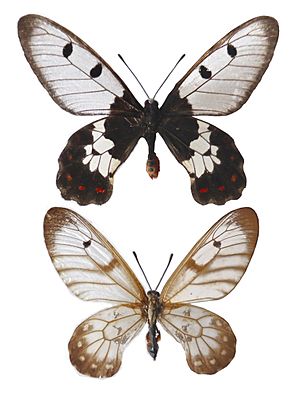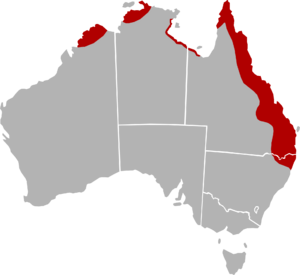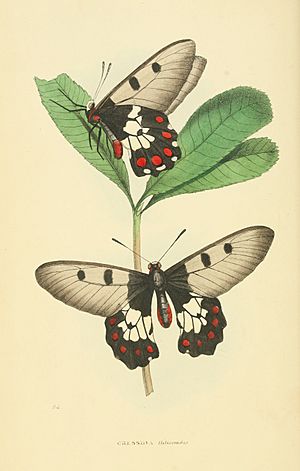Clearwing swallowtail facts for kids
Quick facts for kids Clearwing swallowtail |
|
|---|---|
 |
|
| Dorsal perspective of male (above) and female (below) C. c. cressida mounted specimens. A sphragis is partially visible on the female. | |
| Scientific classification | |
| Kingdom: | |
| Phylum: | |
| Class: | |
| Order: | |
| Family: | |
| Genus: |
Cressida
Swainson, 1832
|
| Species: |
C. cressida
|
| Binomial name | |
| Cressida cressida (Fabricius, 1775)
|
|
 |
|
| Distribution map of Cressida cressida in Australia. Note: distribution is not limited to Australia. | |
The clearwing swallowtail (Cressida cressida) is a unique butterfly. It is also known as the big greasy. You can find it in northern Australia, New Guinea, the Maluku Islands, and Timor. This butterfly is the only species in its group, called Cressida.
Interestingly, this butterfly is not closely related to other Asian swallowtails. Instead, it seems to be a close relative of the unusual South American Euryades butterflies.
Contents
About the Clearwing Swallowtail
How it Got its Name
The first clearwing swallowtail butterflies were collected in 1770. This happened near what is now Cooktown, Queensland. Johann Fabricius described them. He thought the male and female were different species at first. He named the male Papilio cressida and the female P. harmonia.
Later, scientists realized they were the same species. Both sexes now share the name cressida. The butterfly is no longer in the Papilio group. It is now in its own group, Cressida. The original butterflies are kept at the Natural History Museum, London.
Different Types of Clearwing Swallowtails
The clearwing swallowtail has different types, called subspecies. These live in various places:
- C. c. cressida – found in north-eastern Australia and Maluku
- C. c. insularis – found in Timor
- C. c. cassandra – found in north-western Australia
- C. c. troilus – found in New Guinea
What the Butterfly Looks Like
Life Stages
The eggs of the clearwing swallowtail can be very different in size. The caterpillars come in many colors. They have special yellow scent glands called osmeteria. These glands release a sweet smell. Caterpillars often eat all the food plant they are on. Then, they crawl on the ground to find another plant.
The chrysalis (the pupa stage) looks like marble. It attaches itself to dead grass or stones.
Adult Butterflies
Adult male and female clearwing swallowtails look quite different. This is called sexual dimorphism. Both sexes have a black body with some red scales. Their wings are tough and see-through. They do not have many scales on them. These butterflies can also vary a lot in size.
Male butterflies have a wingspan of about 80 millimeters (about 3 inches). This is wider than the female's wingspan. Their front wings are see-through. They have two black spots and a thin black border. The back wings have a thick black border. Inside this border is a white area with black veins. The black border also has red spots. The size and number of these spots can change. These red spots are a warning color. They tell predators that the butterfly is not tasty. This is because the caterpillars eat poisonous plants.
Female butterflies have a wingspan of about 70 millimeters (about 2.7 inches). Their wings are a bit see-through and a brownish-yellow color. This color is strongest right after the butterfly comes out of its chrysalis. But it soon fades, making the wings almost completely clear. The patterns on the female's wings are similar to the male's. However, they are much lighter and spread out. The white areas on the back wings are very small. All the red markings are replaced by pale pink. The size of the black band on the back wing changes depending on where the butterfly lives.
Special Mating Feature
After mating, the male clearwing swallowtail leaves a special structure on the female. This structure helps prevent other males from mating with her. This increases the chance that his offspring will be born.
However, females have developed a way to make it harder for this structure to stay in place. Females benefit from mating multiple times. Each mating provides them with extra nutrients. This special structure does not block the female from laying eggs.
Where They Live and What They Eat
The clearwing swallowtail caterpillars eat plants from the Aristolochia family. These plants are poisonous. Because the caterpillars eat these plants, the adult butterflies become unappetizing to predators.
The Papilio anactus butterfly looks and flies like the male clearwing swallowtail. This helps it avoid predators too. It's like a harmless animal pretending to be a dangerous one. This is called Batesian mimicry.
Clearwing swallowtails mostly live in drier forests. In Australia, you often find them in dry Eucalyptus forests. Here, their food plants grow as small climbing plants in open areas. They are most common in forests near the Great Dividing Range. This butterfly species is not currently in danger.
How They Behave
The clearwing swallowtail flies slower and more smoothly than most other swallowtails. But if something disturbs it, it can fly very fast.
Male butterflies usually fly around breeding areas. They fly about one to three meters (3-10 feet) above the ground. They are looking for females and rarely land. Males will aggressively protect areas where the caterpillars' food plants grow. Larger males are usually more successful at this.
Males try to mate with females in mid-air. Smaller males might carry the female to the ground to mate. If a female already has the special structure from a previous mating, males might still try to catch her. But they usually let her go quickly.
Female butterflies tend to fly closer to the ground. They are looking for good plants to lay their eggs on. If a female has already mated, she will show she is not available. She does this by raising her abdomen and lowering her wings while flying. This shows the special structure she is carrying.
See also
 In Spanish: Cressida para niños
In Spanish: Cressida para niños



